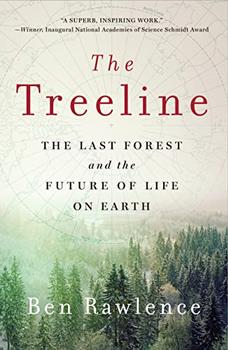Summary | Excerpt | Reviews | Beyond the book | Read-Alikes | Genres & Themes | Author Bio

How Our Planet Came to Life
by Ferris JabrThe idea of Earth as one living, breathing organism is an age-old one, found in belief systems all over the world. Yet when it was first seriously proposed as a scientific hypothesis in the 1970s—the Gaia hypothesis, named after the Greek goddess of the Earth, which posited that the planet itself is alive via interconnected systems—it was the subject of ridicule among scientists.
Now that outlook is changing, and the scientific community is increasingly aware of and interested in the previously overlooked interplay between living organisms, as well as between living and non-living components of ecosystems. Ferris Jabr's new book, Becoming Earth: How Our Planet Came to Life, is an easily readable introduction to the science of ecological interconnections, and it serves as a behind-the-scenes glimpse into the planet's physical and biological forces acting upon each other in reciprocal and significant ways.
Jabr structures the book like the planet he describes—sections are arranged by rock, water, and air, with three chapters in each covering microbes, complex life forms, and, finally, humans' impact on each sphere. This form gives the book a rhythmic quality reminiscent of seasons, migrations, and other ecological cycles.
He takes the reader into the depths of the Earth's crust, miles below the surface, where recently discovered microbes modify the chemical composition of the rocks and sediments around them. Early microbial activity billions of years ago may even have influenced plate tectonics and the formation of continents by dissolving rocks and minerals on the ocean floor and accelerating the forces that produced new land.
This section is the most ground-breaking, no pun intended, since we most often assume the Earth's crust and plates only exert one-way forces on living creatures. But that's not to say that the hydrosphere or atmosphere are without surprises. Jabr describes how plankton in the oceans remove carbon dioxide from the atmosphere to the point that, if left unchecked, their activity cools the planet to ice age levels. Conversely, those ice ages stall the plankton's activity, which leads to a build-up of carbon dioxide and results in planetary warming. It's a poignant reminder of the strength of non-human organisms in driving the planet's crucial functions, but also a warning about throwing those organisms and planetary rhythms off balance.
In a similar vein, the revelation that geologic forces are merging plastic and rock into a hybrid called "plastiglomerate" is a stunning example of the Earth's resiliency, but it's also a depressing reminder of the levels our detritus have reached. Chapters on humans' impacts on soils with chemical fertilizers (see Beyond the Book) and suppression of fire cycles are also disheartening but finish on hopeful notes. In the latter, for example, Jabr discusses how Indigenous knowledge of fire's regenerative abilities is finally being taken seriously; in 2022, the Forest Service announced a strategy of more prescribed burns. When managed properly, prescribed burns can prevent bigger conflagrations by burning off excess fuel in forests and grasslands. With wildfires reaching increasingly disastrous levels, particularly in the American West, this change in strategy is not a moment too soon.
Throughout the book, Jabr does an excellent job of soberly explaining the climate crisis and humanity's responsibility for it while continuously emphasizing a path forward. There are ways to alter our decision-making to work in tandem with all of Earth's systems rather than trying to dominate them, including reintroducing grazers to permafrost ecosystems to cool soils, using fire to prevent bigger fires, and making the all-important shift to renewable energy. His cautious optimism is contagious, without being over the top.
In Becoming Earth, Jabr travels from the rainforest to Siberia, from caves deep within Earth's crust to towers thousands of feet above the surface, and along the way introduces the reader to scientists whose work is awakening humanity to the crucial connections between all living things. We meet cave-diving microbiologists, engineers growing kelp forests for carbon storage, a museum curator studying plastic pollution via autopsies on ocean mammals, and more. These people's stories and Jabr's observations of their work give the book the feel of an extended piece of reporting, not a dry textbook.
And Jabr's prose can be novelistic and exciting; he uses sweeping, dramatic descriptions to capture, for example, the collective impact of single-celled plankton: "In their eon-spanning metamorphosis—their transformation from floating cell to entombed rock to windswept dust and back again—they embody the reciprocity of life and environment and the perpetual reincarnation of Earth." Later, he describes "the tantalizing shimmer of a blue Morpho butterfly and the delicacy of a ghost plant's milky flower trembling on a wiry stalk." With his eye for Earth's beauty and his understanding of the impact of its smallest organisms, Jabr has written a book that celebrates the planet and inspires readers to see it differently—and to better protect it.
![]() This review was originally published in The BookBrowse Review in August 2024, and has been updated for the
May 2025 edition.
Click here to go to this issue.
This review was originally published in The BookBrowse Review in August 2024, and has been updated for the
May 2025 edition.
Click here to go to this issue.

If you liked Becoming Earth, try these:

by Ben Goldfarb
Published 2024
An eye-opening account of the global ecological transformations wrought by roads, from the award-winning author of Eager.

by Ben Rawlence
Published 2023
In the tradition of Elizabeth Kolbert and Barry Lopez, a powerful, poetic and deeply absorbing account of the "lung" at the top of the world.
Your guide toexceptional books
BookBrowse seeks out and recommends the best in contemporary fiction and nonfiction—books that not only engage and entertain but also deepen our understanding of ourselves and the world around us.